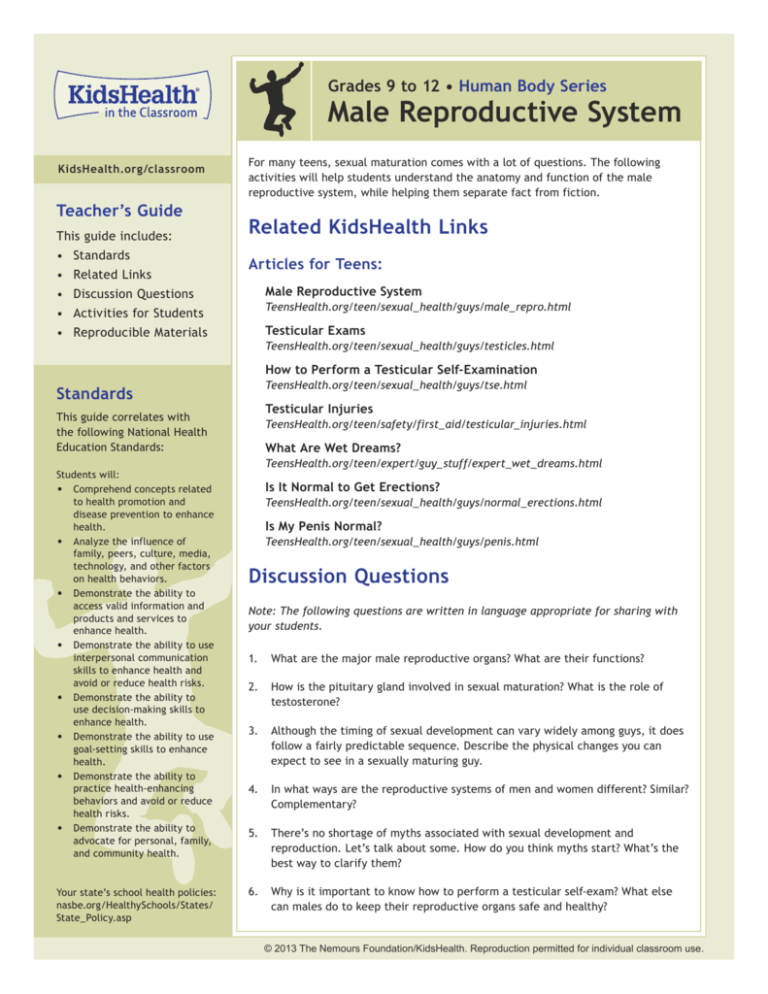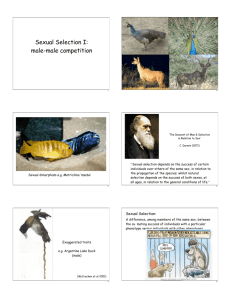
Grades 9 to 12 • Human Body Series
Male Reproductive System
KidsHealth.org/classroom
Teacher’s Guide
This guide includes:
• Standards
• Related Links
• Discussion Questions
• Activities for Students
• Reproducible Materials
For many teens, sexual maturation comes with a lot of questions. The following
activities will help students understand the anatomy and function of the male
reproductive system, while helping them separate fact from fiction.
Related KidsHealth Links
Articles for Teens:
Male Reproductive System
TeensHealth.org/teen/sexual_health/guys/male_repro.html
Testicular Exams
TeensHealth.org/teen/sexual_health/guys/testicles.html
How to Perform a Testicular Self-Examination
Standards
This guide correlates with
the following National Health
Education Standards:
Students will:
• Comprehend concepts related
to health promotion and
disease prevention to enhance
health.
• Analyze the influence of
family, peers, culture, media,
technology, and other factors
on health behaviors.
• Demonstrate the ability to
access valid information and
products and services to
enhance health.
• Demonstrate the ability to use
interpersonal communication
skills to enhance health and
avoid or reduce health risks.
• Demonstrate the ability to
use decision-making skills to
enhance health.
• Demonstrate the ability to use
goal-setting skills to enhance
health.
• Demonstrate the ability to
practice health-enhancing
behaviors and avoid or reduce
health risks.
• Demonstrate the ability to
advocate for personal, family,
and community health.
Your state’s school health policies:
nasbe.org/HealthySchools/States/
State_Policy.asp
TeensHealth.org/teen/sexual_health/guys/tse.html
Testicular Injuries
TeensHealth.org/teen/safety/first_aid/testicular_injuries.html
What Are Wet Dreams?
TeensHealth.org/teen/expert/guy_stuff/expert_wet_dreams.html
Is It Normal to Get Erections?
TeensHealth.org/teen/sexual_health/guys/normal_erections.html
Is My Penis Normal?
TeensHealth.org/teen/sexual_health/guys/penis.html
Discussion Questions
Note: The following questions are written in language appropriate for sharing with
your students.
1. What are the major male reproductive organs? What are their functions?
2. How is the pituitary gland involved in sexual maturation? What is the role of
testosterone?
3. Although the timing of sexual development can vary widely among guys, it does
follow a fairly predictable sequence. Describe the physical changes you can
expect to see in a sexually maturing guy.
4. In what ways are the reproductive systems of men and women different? Similar?
Complementary?
5. There’s no shortage of myths associated with sexual development and
reproduction. Let’s talk about some. How do you think myths start? What’s the
best way to clarify them?
6. Why is it important to know how to perform a testicular self-exam? What else
can males do to keep their reproductive organs safe and healthy?
© 2013 The Nemours Foundation/KidsHealth. Reproduction permitted for individual classroom use.
Grades 9 to 12 • Human Body Series
Male Reproductive System
Activities for Students
Note: The following activities are written in language appropriate for sharing with your students.
Sperm Assembly Line
Objectives:
Students will:
• Learn the function of each part of the male reproductive system as it relates to sperm production
Materials:
•
•
•
Computer with Internet access
“Sperm Assembly Line” handout
Pen or pencil
Class Time:
•
40 minutes
Activity:
Unlike females, who have all their eggs present at birth and only release them one by one during menstruation, a
sexually mature guy makes millions of sperm a day. In fact, if sperm production were an assembly line, it just might
be considered one of the most efficient of all time.
But where does a sperm cell start? How does it develop? Where does it go?
Create a chain diagram that shows the path of a sperm from creation to ejaculation. Be sure to include what the
sperm looks like, how it moves, and what happens at each of the following body parts:
•
testicles
•
seminiferous tubules
•
epididymis
•
vas deferens
•
seminal vesicles
•
prostate gland
•
urethra
•
penis
Extension:
Continue the sperm’s journey as it moves on to ejaculation. During sex, millions of sperm are released via semen into
the female’s vagina. Write two paragraphs describing what happens next – one describing what will happen if the
sperm meets a mature egg cell there and one describing what will happen if it doesn’t.
© 2013 The Nemours Foundation/KidsHealth. Reproduction permitted for individual classroom use.
Grades 9 to 12 • Human Body Series
Male Reproductive System
Hey, Little Brother
Objectives:
Students will:
• Write a letter demonstrating their knowledge of puberty, sexual development, and reproduction
Materials:
•
•
•
Computer with Internet access
“Hey, Little Brother” handout
Pen or pencil
Class Time:
•
45 minutes
Activity:
Your 12-year-old brother came to you and said that when he woke up, the bed was sticky and wet. He seemed
embarrassed and confused. Fortunately, you’ve been there before and know exactly what’s going on. While he’s at
basketball practice today, you decide to write him a note explaining what wet dreams are and why they are no big
deal. While you’re at it, you also decide to include some of the other stuff you’re sure is going through his mind as he
wonders what’s normal and what’s not about puberty and sexual development. Be factual, use correct terms, and do
your best to reassure him that this is all perfectly normal.
Extension:
Work in groups or individually to turn what you wrote into a brochure to help spread the message to other kids as
well.
Reproducible Materials
Handout: Sperm Assembly Line
TeensHealth.org/classroom/9to12/body/systems/male_reproductive_handout1.pdf
Handout: Hey, Little Brother
TeensHealth.org/classroom/9to12/body/systems/male_reproductive_handout2.pdf
Quiz: Male Reproductive System
TeensHealth.org/classroom/9to12/body/systems/male_reproductive_quiz.pdf
Answer Key: Male Reproductive System
TeensHealth.org/classroom/9to12/body/systems/male_reproductive_quiz_answers.pdf
KidsHealth.org is devoted to providing the latest children’s health information. The site, which is widely
recommended by educators, libraries, and school associations, has received the “Teachers’ Choice Award
for the Family” and the prestigious Pirelli Award for “Best Educational Media for Students.” KidsHealth comes
from the nonprofit Nemours Foundation. Check out www.KidsHealth.org to see the latest additions!
© 2013 The Nemours Foundation/KidsHealth. Reproduction permitted for individual classroom use.
Name:
Human Body Series
Male Reproductive System
Date:
Sperm Assembly Line
Instructions: Create a chain diagram that describes the journey of a sperm, from creation to ejaculation.
© 2013 The Nemours Foundation/KidsHealth. Reproduction permitted for individual classroom use.
Human Body Series
Male Reproductive System
Name:
Date:
Hey, Little Brother
Instructions: Write a note to your younger brother letting him know what changes he can expect as he matures sexually.
Hey, Little Brother,
© 2013 The Nemours Foundation/KidsHealth. Reproduction permitted for individual classroom use.
Human Body Series
Male Reproductive System
Name:
Date:
Quiz
Instructions: Answer each question.
1. The fluid that carries and nourishes the sperm is called .
2. Humans pass characteristics of themselves to the next generation through their:
a) sperm
b) discharge
c) gonads
d) genes
3. True or false: Erections are always caused by sexual arousal.
4. The penis has two main parts: the and the .
5. True or false: There are exercises guys can do to make their penises larger.
6. “Nocturnal emission” is the medical term for .
7. The male accessory glands include the and the .
8. The duct system is made up of the and the .
9. True or false: When semen comes out of the penis, it’s called ejaculation.
10. All boys are born with a , a fold of skin at the end of the penis that covers the glans.
© 2013 The Nemours Foundation/KidsHealth. Reproduction permitted for individual classroom use.
Human Body Series
Male Reproductive System
Quiz Answer Key
1. The fluid that carries and nourishes the sperm is called semen
.
2. Humans pass characteristics of themselves to the next generation through their:
a) sperm
b) discharge
c) gonads
d) genes
3. True or false: Erections are always caused by sexual arousal.
shaft
4. The penis has two main parts: the and the glans
.
5. True or false: There are exercises guys can do to make their penises larger.
6. “Nocturnal emission” is the medical term for 7. The male accessory glands include the wet dream .
prostate gland
and the epididymis and the 8. The duct system is made up of the seminal vesicle
vas deferens
.
.
9. True or false: When semen comes out of the penis, it’s called ejaculation.
10. All boys are born with a foreskin
, a fold of skin at the end of the penis that covers the glans.
© 2013 The Nemours Foundation/KidsHealth. Reproduction permitted for individual classroom use.









